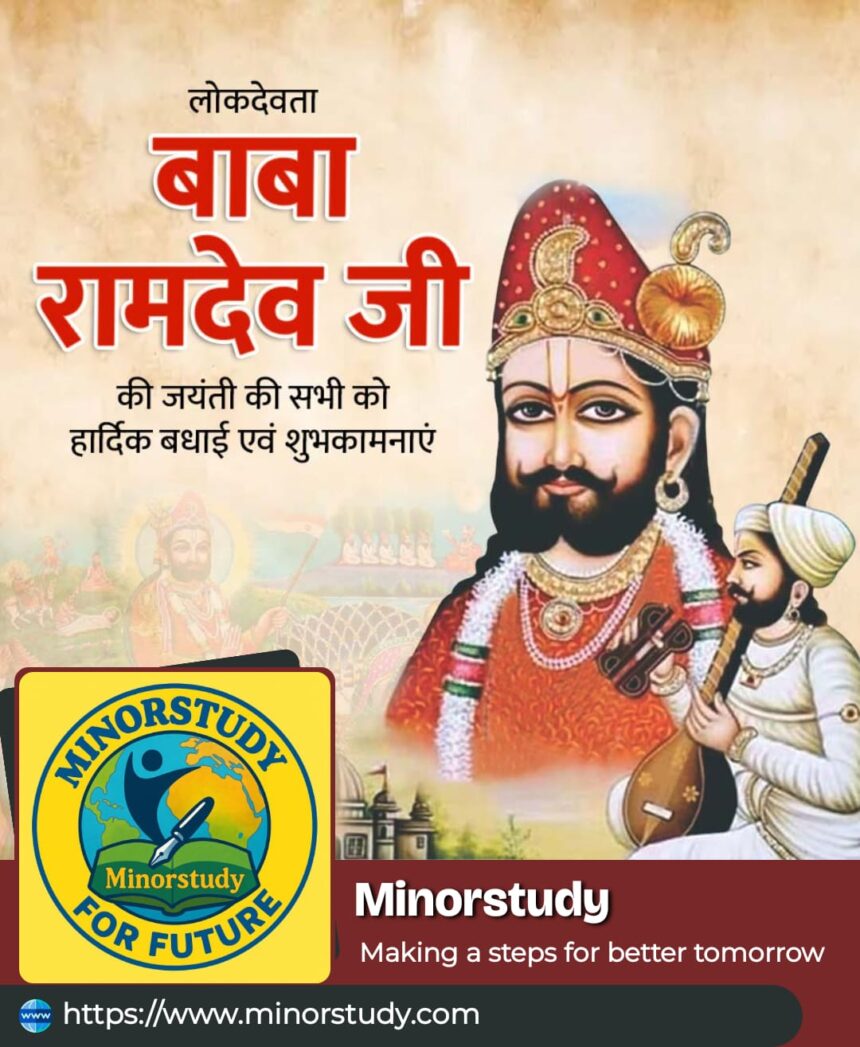Baba Ramdev Ji Remains a Beloved Symbol of Faith and Unity
✨ Introduction
India’s cultural and spiritual history is deeply enriched by saints and folk deities who worked tirelessly for equality, harmony, and devotion. Among them, Baba Ramdev Ji, also known as Ramdev Pir or Ramsha Pir, holds a very special place in the hearts of millions, especially in Rajasthan and Gujarat.
- ✨ Introduction
- 📜 History of Baba Ramdev Ji
- 📊 Timeline of Baba Ramdev Ji’s Life
- ✅ 10 Interesting Facts About Baba Ramdev Ji
- 🌍 Significance of Baba Ramdev Ji
- 📌 Observance and Worship
- 🙏 Wishing Messages (Human-Friendly Tone)
- 📖 FAQs About Baba Ramdev Ji
- 🙌 Daily Life Impact and Importance in Society
- 🌟 Conclusion – Baba Ramdev Ji’s Everlasting Legacy
Baba Ramdev Ji is revered as an incarnation of Lord Krishna by Hindus and equally respected as a peer (saint) by Muslims. His life was dedicated to removing social divisions, spreading the values of equality, devotion, and service to humanity.
Even centuries after his passing, his legacy continues to inspire countless devotees. Temples, songs, festivals, and fairs dedicated to him reflect how Baba Ramdev Ji became a symbol of interfaith harmony and social reform.
In this article, let’s explore the history, facts, timeline, significance, observance, and daily life impact of Baba Ramdev Ji’s teachings.
📜 History of Baba Ramdev Ji
Baba Ramdev Ji was born around 1409 CE in Runicha (Runicha Dham), located in present-day Rajasthan, into the Rathore Rajput family of King Ajmal Ji.
He was believed to be a divine child, considered by many as a reincarnation of Lord Krishna.
From childhood, Ramdev Ji showed extraordinary spiritual inclination and deep compassion for the poor and marginalized.
He rejected social barriers like caste discrimination and untouchability, emphasizing that all human beings are equal before God.
His teachings attracted followers from various communities—Hindus, Muslims, and others.
He was known for performing miracles, healing the sick, and uplifting the downtrodden.
Baba Ramdev Ji attained Samadhi (final meditation) in 1459 CE at Runicha, where his temple (Ramdevra Mandir) still stands as a grand pilgrimage site.
📊 Timeline of Baba Ramdev Ji’s Life
1409 CE: Birth of Baba Ramdev Ji in Runicha, Rajasthan.
Early 15th century: Begins preaching equality, social justice, and devotion.
Mid-15th century: Gains a large following across Rajasthan, Gujarat, and Sindh.
1459 CE: Attains Samadhi at Runicha, now known as Ramdevra.
Post-15th century: His fame spreads across India; devotees build temples and shrines.
Modern Era: Ramdevra Fair attracts lakhs of devotees annually.
✅ 10 Interesting Facts About Baba Ramdev Ji
Baba Ramdev Ji is revered by both Hindus and Muslims.
Muslims affectionately call him Ramsha Pir, while Hindus worship him as an incarnation of Krishna.
His main shrine is located at Ramdevra, Jaisalmer, Rajasthan, which attracts millions during the Ramdevra Fair.
Baba Ramdev Ji’s philosophy was based on equality and service to humanity.
He opposed caste-based discrimination and welcomed people of all backgrounds.
Devotees often offer chadars (sacred cloths) at his dargah-like temple.
He is also worshipped in Gujarat and Sindh (Pakistan), showing his cross-border influence.
Folk songs, bhajans, and kirtans dedicated to him are still sung widely.
The temple at Ramdevra is managed like a dargah-temple blend, symbolizing Hindu-Muslim unity.
The Ramdevra Mela (fair) is one of the largest folk fairs in India, celebrating his legacy.
🌍 Significance of Baba Ramdev Ji
Baba Ramdev Ji’s life carries deep meaning for society even today:
Religious Harmony: His acceptance by Hindus and Muslims reflects his role as a bridge between communities.
Social Reform: He openly rejected caste barriers and supported equality.
Spiritual Devotion: His teachings inspire faith in truth, love, and service to humanity.
Cultural Legacy: Folk music, fairs, and traditions based on his life enrich India’s cultural heritage.
📌 Observance and Worship
The Ramdevra Fair (held annually in August–September, during Bhadrapada Shukla Paksha) is the biggest celebration of Baba Ramdev Ji.
Devotees from across India, especially Rajasthan, Gujarat, Madhya Pradesh, and Maharashtra, gather at Ramdevra Mandir.
Rituals include singing bhajans, offering prasad, and seeking blessings for peace, prosperity, and harmony.
Pilgrims walk barefoot to Ramdevra, symbolizing devotion and humility.
🙏 Wishing Messages (Human-Friendly Tone)
“On the occasion of Baba Ramdev Ji’s remembrance, may his teachings of equality, harmony, and devotion guide our lives.”
“Let us bow to Baba Ramdev Ji, the saint who united people across faiths and worked for humanity.”
“May Baba Ramdev Ji bless you with peace, prosperity, and the strength to serve others selflessly.”
📖 FAQs About Baba Ramdev Ji
Q1: Who was Baba Ramdev Ji?
👉 A 15th-century saint and folk deity of Rajasthan, revered as both a Hindu incarnation of Krishna and a Muslim saint (Ramsha Pir).
Q2: Where is Baba Ramdev Ji’s main temple?
👉 At Ramdevra, Jaisalmer (Rajasthan).
Q3: What was his main teaching?
👉 Equality, service to humanity, and devotion to God.
Q4: Why do Muslims also revere him?
👉 His message of love and miracles attracted Muslims, who regard him as Ramsha Pir.
Q5: What is the Ramdevra Fair?
👉 An annual pilgrimage where lakhs of devotees gather at Ramdevra Mandir to honor Baba Ramdev Ji.
🙌 Daily Life Impact and Importance in Society
Promotes Harmony: Baba Ramdev Ji’s message encourages people today to rise above religion and caste.
Inspires Service: His life reminds us that true devotion lies in helping the needy and marginalized.
Cultural Identity: For Rajasthan and Gujarat, he is a folk icon, shaping festivals, traditions, and songs.
Tourism & Economy: Ramdevra Fair boosts local trade, creating livelihood opportunities.
Modern Relevance: In times of division, his teachings remain a guiding light for peace and inclusivity.
🌟 Conclusion – Baba Ramdev Ji’s Everlasting Legacy
Baba Ramdev Ji was not just a saint of the 15th century; he was a revolutionary spiritual leader who rose against inequality and stood for unity in diversity. His life continues to echo in every devotee’s heart, reminding us of the power of compassion, humility, and service.
Even today, when social divisions remain a challenge, Baba Ramdev Ji’s teachings stand as a beacon of hope—guiding humanity toward a more equal, peaceful, and loving society.
To remember him is not just to celebrate history, but to embrace his vision in our daily lives: live simply, serve others, and respect all.









This is the precise weblog for anyone who wants to find out about this topic. You realize a lot its virtually laborious to argue with you (not that I truly would need…HaHa). You undoubtedly put a new spin on a topic thats been written about for years. Great stuff, simply nice!